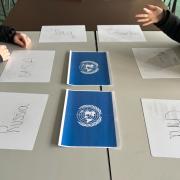
How to teach every child. Interview with Sara Alston, co-author of The Inclusive Classroom: A new approach to Differentiation.
A teacher’s job includes a bit of planning, a bit of marking, and of course, a lot of teaching, right? However, planning lessons is easier said than done, when, as in every class one pupil has finished the work in 10 minutes while another is struggling to even focus on the task.
So, how can teachers find a way to meet the needs of all their students effectively, while not spending hours creating a one-size-fits-all worksheet?
Sara Alston, an experienced primary school teacher who now works as a consultant in safeguarding and special needs, has the answers in the new book The Inclusive Classroom: A new approach to Differentiation, which she has co-authored with Daniel Sobel.
To ensure that everyone is included in the class, teachers need to meet everyone’s needs. This is known as ‘differentiation’. Alston explains, “in some schools it has become all about teachers showing that they’ve planned for different groups of children, and very little about actually meeting the different groups of children’s needs.” This can make planning lessons stressful for teachers and is often less useful for students.
The book also focuses on the importance of meeting children’s needs rather than diagnosing them. “The other thing that gets in the way of meeting children’s needs is that they are given a label, a diagnosis. Teachers need to look at the needs of the child, not the label they’re given, because often those labels obscure what the child’s actual needs are.” Alston gives the example of dyslexia: one person’s experience of dyslexia may be completely different to someone else’s, and while a certain approach may benefit one student, it could hinder another.
“So, what we looked at in the book was what we called ‘small tweaks and adaptations’, that work for all children. It’s not just about children with special needs, it’s about making lessons and learning more accessible for all children without adding to the stress and workload of teachers.” These ‘small tweaks’ split the lesson into five phases to help the teacher to plan.
The first of these five phases is the transition into the room. “We talk about simple things like greeting the children as they come into the room, which gives you a chance to assess how they are.” Alston outlined how to make the students feel more comfortable, for example, by having a visual timetable of the lesson so that they will know what to expect.
“Phase two is about giving instructions.” The book gives tips on how to do this so that the class is engaged and ready to participate and gives alternatives to less effective methods.
“Phase three is about the individual, a child working as an individual in the lesson and things to support them to access the learning. For example, for many it makes no difference if they are asked to write the date and learning intention and a title. They can do that in a couple of seconds and don’t have to think about it. But some children, by the time they’ve done that, they’ve used so much of their learning energy, that they’re not able to do any of the actual learning.”
“Phase four of the lesson is about group work. That can be really difficult because if you have any kind of learning difficulty, as soon as you work in a group, you’re exposed. If you struggle with reading, you can probably cover that up to an extent in the main body of the class, but when put in a group, it can be much more difficult”.
Phase five focuses on the last five minutes of the lesson. Alston says that this is the one that she finds most interesting because little has been written about it. “In those last five minutes you are asking children [and teachers] to do an awful lot because of all the stuff of finishing up the lesson, recapping the learning and getting people out the room safely. But the thing we forget is that the last five minutes of one lesson is the first five minutes effectively of whatever happens next. Some children, as soon as you stop at the end of the lesson, they’re thinking ‘I’m going to have to deal with the school corridor, I’m going to have to deal with lunchtime, I’m going to have to deal with my journey home and all those different stresses.’”
“We’ve worked through those five phases of the lesson looking at simple ideas, case studies and ‘instead of this, do this’ giving them real clear tips they can use”.
It is available for pre-order on Bloomsbury here, with a 30% discount code INCLUSIVE30 until 7/1/2021 or on amazon, here (with no discount on amazon).



























